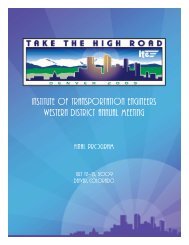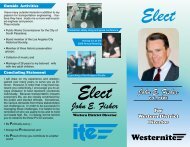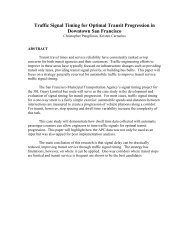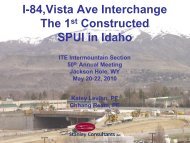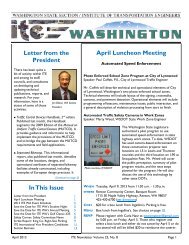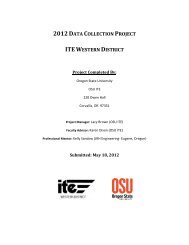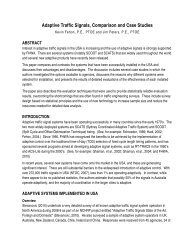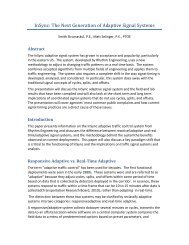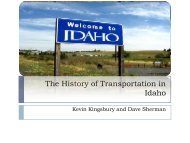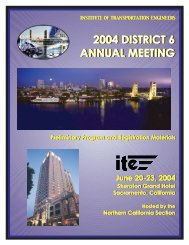Using NCHRP Report 562 in Evaluating Pedestrian Crossings
Using NCHRP Report 562 in Evaluating Pedestrian Crossings
Using NCHRP Report 562 in Evaluating Pedestrian Crossings
You also want an ePaper? Increase the reach of your titles
YUMPU automatically turns print PDFs into web optimized ePapers that Google loves.
<strong>Us<strong>in</strong>g</strong> <strong>NCHRP</strong> <strong>Report</strong> <strong>562</strong> <strong>in</strong><br />
Evaluat<strong>in</strong>g <strong>Pedestrian</strong> Cross<strong>in</strong>gs<br />
ITE Intermounta<strong>in</strong> Section Meet<strong>in</strong>g<br />
May 21, 2010<br />
Ryan Peterson, PE, PTOE<br />
Project Eng<strong>in</strong>eer<strong>in</strong>g Consultants
Background<br />
• Several recent projects evaluat<strong>in</strong>g pedestrian<br />
cross<strong>in</strong>gs:<br />
– 11 th Ave. <strong>Pedestrian</strong> cross<strong>in</strong>g<br />
– BYU-I Campus-Wide <strong>Pedestrian</strong> Study<br />
• Observations of difficulties faced by public<br />
agencies<br />
– Citizen requests<br />
– High profile cases
Problem:<br />
• Need a defendable framework for evaluat<strong>in</strong>g<br />
the appropriateness of different crosswalk<br />
treatments.
<strong>NCHRP</strong> <strong>562</strong><br />
• Two Ma<strong>in</strong> Objectives<br />
– Recommend selected<br />
eng<strong>in</strong>eer<strong>in</strong>g treatments to<br />
improve safety for pedestrians<br />
cross<strong>in</strong>g high-volume, high-speed<br />
roadways at unsignalized<br />
<strong>in</strong>tersections, <strong>in</strong> particular on<br />
roads served by public<br />
transportation; and<br />
– Recommend modifications to the<br />
Manual on Uniform Traffic<br />
Control Devices (MUTCD)<br />
pedestrian traffic signal warrant.
<strong>NCHRP</strong> <strong>562</strong> Cont’d<br />
• Chapters 1 and 2: Background and Ped<br />
Characteristics<br />
• Chapter 3: Review of <strong>Pedestrian</strong> Cross<strong>in</strong>g<br />
Treatments<br />
– Traffic Signal and Red Beacon Displays<br />
– Flash<strong>in</strong>g Beacons<br />
– In-Roadway Warn<strong>in</strong>g Lights<br />
– Motorist Warn<strong>in</strong>g Signs and Pavement mark<strong>in</strong>gs<br />
– Crosswalk Pavement mark<strong>in</strong>gs<br />
– Roadway Design Elements
<strong>NCHRP</strong> <strong>562</strong> Cont’d<br />
• Chapter 4: Review of <strong>Pedestrian</strong> Signal<br />
Warrant<br />
• Chapter 5: F<strong>in</strong>d<strong>in</strong>gs from Surveys<br />
• Chapters 6 & 7: Field Surveys and F<strong>in</strong>d<strong>in</strong>gs<br />
• Chapter 8: Conclusions and Recommendations<br />
– Guidel<strong>in</strong>es for <strong>Pedestrian</strong> Cross<strong>in</strong>g Treatments
Guidel<strong>in</strong>es for <strong>Pedestrian</strong> Cross<strong>in</strong>g<br />
Treatments<br />
• Provide general recommendations:<br />
– “Red” – Signal or other red <strong>in</strong>dication<br />
– “Active or Enhanced”<br />
– “Crosswalk”<br />
• Eng<strong>in</strong>eer<strong>in</strong>g Judgment is used for f<strong>in</strong>al<br />
treatment selection<br />
• Comb<strong>in</strong>ation of treatments
Guidel<strong>in</strong>es for <strong>Pedestrian</strong> Cross<strong>in</strong>g<br />
Treatments Cont’d<br />
• Input variables:<br />
– Speed on the major street<br />
– Ped cross<strong>in</strong>g distance<br />
– Peak-hour (4-hour) pedestrian and vehicle<br />
volumes<br />
– Peak-hour lane widths<br />
– Expected motorists compliance (high or low)<br />
– Ped walk<strong>in</strong>g speed<br />
– Ped start-up time and end clearance time
Guidel<strong>in</strong>es for <strong>Pedestrian</strong> Cross<strong>in</strong>g<br />
Treatments Cont’d<br />
• Calculations:<br />
– Signal warrant check<br />
– Critical gap<br />
– Major road flow rate<br />
– Average ped delay<br />
– Total ped delay<br />
• Total ped delay and expected driver<br />
compliance are used to determ<strong>in</strong>e treatment<br />
category
BYU-I Campus-wide <strong>Pedestrian</strong> Study<br />
• Recent pedestrian issues <strong>in</strong> the area<br />
• Four ma<strong>in</strong> corridors around campus<br />
• 20 cross<strong>in</strong>g locations<br />
• Very high pedestrian volumes<br />
• J-walk<strong>in</strong>g<br />
• Roadway Light<strong>in</strong>g
Signal Warrant Analysis<br />
• Worksheet uses recommendations of report<br />
for changes to MUTCD warrant<br />
• Signal Warrant Analysis <strong>in</strong>cluded:<br />
– 2003 MUTCD<br />
– Proposed Amendments for 2009 MUTCD<br />
• Proposed Guidance for Application of <strong>Pedestrian</strong> Hybrid<br />
Signal (HAWK)
Results of <strong>NCHRP</strong> <strong>562</strong> Analysis<br />
• No locations met signal warrants<br />
• Four locations met guidel<strong>in</strong>es for HAWK<br />
– Length of cross<strong>in</strong>gs near 60 – 80’<br />
– Re-evaluated assum<strong>in</strong>g curb extensions – did not<br />
meet guidel<strong>in</strong>es
Results of <strong>NCHRP</strong> <strong>562</strong> Analysis<br />
Location<br />
2003 Signal<br />
Warrant?<br />
2009 Signal<br />
Warrant?<br />
<strong>NCHRP</strong> <strong>562</strong><br />
Recommended<br />
Treatment<br />
Category<br />
Current<br />
Treatment<br />
Category<br />
Site 1 No No Active or Enhanced Crosswalk<br />
Site 2 No No Crosswalk Crosswalk<br />
Site 3 No No<br />
Median/Traffic<br />
Calm<strong>in</strong>g<br />
Median/Traffic<br />
Calm<strong>in</strong>g<br />
Site 4 No No NA Stop-Controlled<br />
Site 5 No No Active or Enhanced Crosswalk<br />
Site 6 No No Crosswalk Active or Enhanced<br />
Site 7 No No Crosswalk Crosswalk<br />
Site 8 No No Active or Enhanced Crosswalk<br />
Site 9 No No Active or Enhanced Crosswalk<br />
Site 10 No No NA Stop-Controlled<br />
Site 11 No No Crosswalk Crosswalk<br />
Site 12 No No Active or Enhanced Crosswalk<br />
Site 12-A No No Crosswalk Crosswalk<br />
Site 13 No No Active or Enhanced Active or Enhanced<br />
Site 14 No No NA Stop-Controlled<br />
Site 15 No No NA Stop-Controlled<br />
Site 16 No No NA Stop-Controlled<br />
Site 17 No No Active or Enhanced Crosswalk<br />
Site 18 No No Active or Enhanced Crosswalk<br />
Site 19 No No Crosswalk Crosswalk<br />
Site 20 No No NA Stop-Controlled
Conclusions<br />
• <strong>NCHRP</strong> <strong>562</strong> research is valuable education tool<br />
• Guidel<strong>in</strong>es for <strong>Pedestrian</strong> Cross<strong>in</strong>g Treatments<br />
– Research based framework for select<strong>in</strong>g<br />
pedestrian cross<strong>in</strong>g treatments<br />
– Eng<strong>in</strong>eer<strong>in</strong>g judgment is still required<br />
• Signal warrant analysis<br />
• Selection of specific treatments
Questions?<br />
Contact Information:<br />
Ryan Peterson PE, PTOE<br />
ryan@pecid.com<br />
208-535-3500




